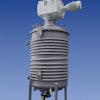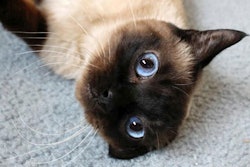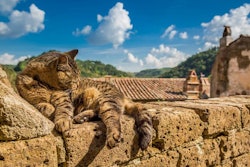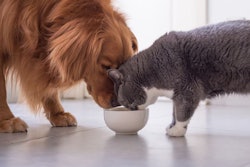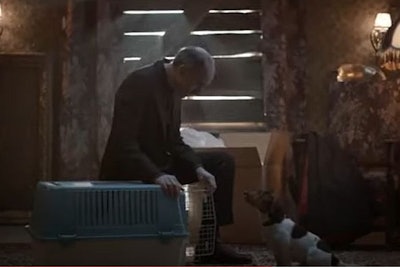
Cat treats are made from people, PEOPLE!
Soylent green isn’t really the latest novel protein, but Mars Petcare marketers took this ultimate step in humanization of pet foods with their seasonal Temptations cat treat. Mars promoted their cat treats as flavored with “tasty humans,” although actually made with beef, liver and chicken.
Aliens too are interested in how to serve man…for dinner. While fleeing the Alien-infested starship Nostromo, last survivor Ellen Ripley took time to save the cat, Jones, from the hungry xenomorph. However, in an advertisement for Mars Petcare brand Pedigree, the dog was left behind after aliens abducted his owner, leaving the dog in need of adoption
Another connoisseur of human flesh, Count Dracula, enjoyed the music made by the howling of wolves, children of the night. Vampires must be canine-lovers, as Count Boris enjoyed the company of a wolf descendant in another Pedigree ad, but the vampire gave up the dog for adoption so his pet could frolic in the daylight with other dogs.
Humor in dog, cat and other pet food and treat marketing
These ads exemplified some of what consumer goods marketer and humorist Tom Fishburne, the Marketoonist, talked about in his opening keynote presentation at Petfood Forum 2021 on Sept. 23. Especially now, as the pandemic drags on, people could use a laugh. However, pet food companies need to use that levity appropriately.
“Humor is needed more than ever,” Fishburne said in an interview. “But often, companies are sensitive to using humor, particularly for the last 18 months. There's this feeling of better to be serious than sorry. Yet, what that does is, unfortunately, every brand starts to sound alike. We all get the same 1,000 emails saying, we are here for you as we navigate the new normal together but apart. That feels like the safest course, but actually, there are ways to use humor appropriately to connect.”
Many types of humor exist, and pet food companies need to use the right type to avoid a bad joke falling flat, he said. Pet food companies should avoid aggressive forms of humor that could offend or anger. Andrew Dice Clay or Howard Stern wouldn’t be great pet food spokespeople. Instead, pet food companies must keep humor in the zone of being self-deprecating or finding a way to laugh with pet owners about what we’re all going through together.
Humor within pet food companies
Making internal audiences laugh can help a pet food company too, Fishburne said. Humor can ease communication while reducing fear and discomfort, leading to greater creativity and collaboration.
“One of the biggest things that can get in the way of creative thinking is silos,” he said. “Humor is often a great way to break down the silos, because humor is ultimately about empathy and connection. There's this old vaudeville quote that laughter is the shortest distance between two people. So, if you can find some shared humor between silos, that can often give you permission to talk about things you really need to talk about, but are often hard to talk about.”
Humor can bridge divides across cultures both in the corporate sense and the global sense. Fishburne gave the example of when he was working with a Singapore-based company to overcome a corporate culture of scolding. However, his first attempt at a cartoon to represent a shamed employee bombed, since it included a boy with a dunce cap on. While American or English people might instantly understand the conical hat as a punishment, in Singapore, a dunce cap was culturally meaningless. Instead, the CEO of the company demonstrated how school children in Singapore are scolded, by crouching in a corner with crossed arms and hands pinching the earlobes. Not only did this instantly communicate the idea of shaming, it also broke down some of the employees’ fear of the senior executive since he was willing to humble himself in that pose.
That CEO’s ability to laugh at oneself to connect with others across cultural chasms is more important than ever, Fishburne said.
“Humor can be an act of empathy,” he said. “It starts with having empathy, not only for who your audience is, but for anyone else in this sphere. Brands starting from a place of empathy will end up will avoid many potential misfires.”
Be aware of power dynamics and think about what the butt of the joke is and make sure that the vibe of the joke is appropriate, he said.
This means that if you're a leader, either within a company or externally in the marker, you don't want to make fun of anyone or another brand that could be construed as lower than you hierarchically. However, making fun of yourself can be incredibly empowering and positive.
In a global pet food industry, humor can build camaraderie and enhance a brand’s image, but those jokes need to remain sensitive to others.


